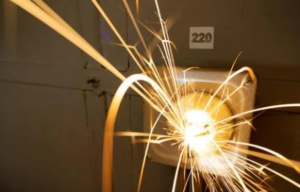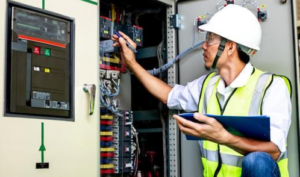Table of Contents
Electricity is integral to modern workplaces, powering everything from computers to industrial machinery. However, this invaluable resource can also pose significant hazards if not managed correctly. Electrical accidents can lead to severe injuries, costly damages, and even loss of life. Therefore, creating a safe and electrically secure work environment is not just a recommendation—it’s a necessity. This article will delve into practical strategies to help you mitigate electrical risks in your workplace.
Know The Most Common Types Of Electrical Hazards

To create a safe work environment, it is crucial that you’re aware of the most common types of electrical hazards. Understanding these risks can proactively prevent accidents and protect your employees. The following are some of the most prevalent electrical hazards found in workplaces:
- Faulty or outdated wiring.
- Poor grounding.
- Overloaded circuits.
- Unsafe use of extension cords.
By identifying these common electrical hazards and taking appropriate measures to address them, you can significantly reduce the risk of electrical accidents in your workplace. Regular inspections and maintenance, proper grounding, circuit planning, and safe use of extension cords are essential steps in creating a safe and electrically secure work environment.
The Significance Of Regular Electrical Inspections And EICRs

Regular electrical inspections are a critical aspect of maintaining a safe work environment. These inspections, often carried out by certified electricians, assess electrical system conditions and identify potential hazards. One of the essential inspections is the Electrical Installation Condition Report (EICR).
An EICR is a comprehensive assessment of electrical installation in a workplace. It examines the condition of wiring, distribution boards, switches, sockets, and other components to ensure they meet safety standards. The EICR provides valuable insights into existing faults, potential risks, and areas that require improvement.
Obtaining an EICR certificate is a legal requirement and a proactive approach to electrical safety. It demonstrates your commitment to maintaining a safe work environment for your employees and visitors.
The EICR cost can vary depending on the size and complexity of the electrical installation. However, the cost should be viewed as an investment in safety rather than an unnecessary expense. The potential consequences of electrical accidents, including injuries, property damage, and legal liabilities, far outweigh the cost of regular inspections and certifications. To learn more about getting an electrical test certificate, go to Hexo Electrical Testing and look at their expert advice and services.
Employee Education And Training On Electrical Safety

Creating a safe and electrically secure work environment goes beyond infrastructure and inspections. Employee education and training on electrical safety play a crucial role in preventing accidents and promoting a culture of safety.
Employees should receive comprehensive training on safety protocols, including proper use of equipment, safe handling of electrical cords, and emergency procedures. This training should be provided to all employees, regardless of their role or level of exposure to electrical hazards.
The training should cover basic electrical concepts, such as understanding voltage, current, and resistance and the importance of grounding and circuit protection devices. Employees should be educated on the potential risks associated with electrical accidents and the steps they can take to prevent them.
Author Profile

- Guest Blogger & Outreach Expert - Interested in Writing Blogs, Articles in Business Niche | News Journalist By Profession in the United Kingdom
Latest entries
 BusinessNovember 21, 2025A Practical Guide to Using LMS Platforms for Better Onboarding
BusinessNovember 21, 2025A Practical Guide to Using LMS Platforms for Better Onboarding EducationNovember 17, 2025Choosing the Right AI Course for Your Child: A Parent’s Guide
EducationNovember 17, 2025Choosing the Right AI Course for Your Child: A Parent’s Guide FinanceSeptember 19, 20257 Paid Advertising Mistakes That Drain Your Marketing Budget
FinanceSeptember 19, 20257 Paid Advertising Mistakes That Drain Your Marketing Budget BusinessAugust 22, 2025How Recycled Polythene Helps Businesses Exceed Sustainability Targets?
BusinessAugust 22, 2025How Recycled Polythene Helps Businesses Exceed Sustainability Targets?





